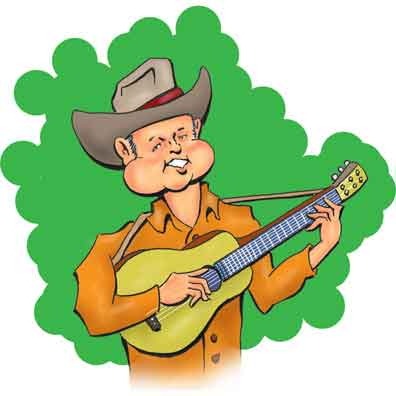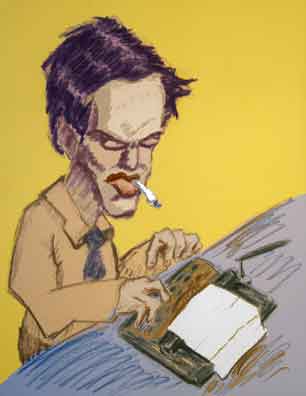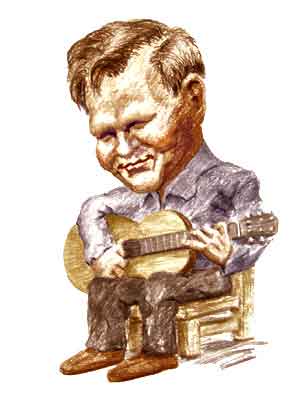Merle Travis
Musicien Extraordinaire!

Merle Travis
The Original
(Click Image to Zoom)
In 1960, folklorist Alan Lomax published Folk Songs of North America. The oeuvres contained therein were (what else?) traditional folk songs of North America: Casey Jones, John Henry, The Old Chisholm Trail. Stuff that all kids know (or at least used to know).
But there were two songs in the book that were written only about a decade earlier. The composer was the country and western performer, Merle Travis. But Alan pointed out that the songs had already gone into oral circulation. So they were bonafide folk songs.
One of the songs was "Dark as a Dungeon" which was about the plight of the coal miners.
Where the rain never falls and the sun never shines,
It's dark as a dungeon way down in the mines.
The other song was "Sixteen Tons". In addition to it speaking generally of the trials and tribulations of working in the mines, it told how the coal companies wouldn't even pay the miners in real money. Instead, the wages were paid in scrip - vouchers issued by the company and which could be redeemed only at the company owned stores.

Alan Lomax
He said they were folk songs.
Of course with the miners working on credit it was easy for the companies to machinate the prices to make sure that they always owed more at the end of the year than their wages covered. This forced the miners into what historians call debt bondage. So they couldn't leave for other types of work even if they wanted to. For all practical purposes they were slaves.
St. Peter don't you call me 'cause I can't go.
I owe my soul to the company store.
Later the companies had to discontinue using scrip and instead paid the miners in real currency. And with the implementation of workplace safety regulations, fatalities in the mines dropped from 177 per 100,000 in 1960 - very high compared to the national average - to about 13 per 100,000. That's still higher than the national norm (about 3.5 per 100,000), but definitely an improvement. (Click on the image at right to see the actual numbers in a new window - or just click here.
Coal mining had (and has) dangers that are often more severe than other mining - metal mining for instance. Coal is softer than, say, hard rock ores, and so collapse of walls and ceilings was a particular danger. Worse, carving out the coal can liberate asphyxiating or poisonous gases (mostly methane) and there were times when coal miners worked in an almost stupefied condition.
Among the other inconveniences was the lack of the conveniences. When you're a mile down in the ground, and you gotta go you gotta go. Some mines set aside certain chambers for the necessary. Others just let the miners (and the mules - yes they had mules underground) manage however they could.
Regardless of the dangers, mining did provide steady employment for men and over the years the pay got better. Kenny Baker, one of the best of the bluegrass fiddle players, played for Bill Monroe for a quarter of a century. He joined the Bluegrass Boys when he was young, but once he married and began to raise a family he preferred the closer-to-home and more reliable job of a coal miner. Only after his kids were grown did he return to music with Bill as a full time professional.
Another "lure of the mines" (to quote Merle) is there was a measure of freedom that other salaried jobs didn't - and still don't - offer. Underground mines - particularly the shaft mines - had miles of tunnels. Today using mechanical transport, it can still take an hour to get from the bottom of the elevator to the actual working chambers. When transportation was on foot or by mule it just wasn't practical for the foreman to stand over the miners. The miners would see the boss maybe once a week.
Besides, any smart foreman knew better than to micromanage. Coal miners had a reputation for independence to the point of cantankerousness. They didn't need whistles or time clocks since they worked until they finished their daily load (which varied as the years went on and mining techniques changed). Also since the miners paid for their own equipment and materials - including the blasting powder - they didn't think anyone should tell them how to do their job.
Merle himself said he didn't really like "Sixteen Tons" that much. But in 1955 Tennessee Ernie Ford turned the song into a #1 hit on both the country and pop charts. In two months the song sold two million copies, and in a few more months that number doubled. Some accounts have the total sales eventually reaching 20 million. "Now I guess it's about my favorite song," Merle said, and in one performance he changed the last line:
I owe my soul ... to Tennessee Ernie Ford.
The popularity of "Sixteen Tons" dropped after a time, but recently it's undergone a resurgence. Then in 2014 the Library of Congress added it to the National Recording Registry as being of cultural and historical significance. In 2017, Merle's album with the song's first release, Folk Songs from the Hills (1947), was also added to the registry.
At this point we need to point out that if you want an original of this album, you might be surprised what you get. In 1947 a record album was literally that. It was a book with pockets for holding the individual records and these played at 78 rpm. Today, of course, this "album" is available in modern formats.
Merle did indeed come from the coal country. He was born on November 29, 1917 in Rosewood, Kentucky to Robert and Etta Travis. The family moved to Ebenezer in the north central part of the state. Rob (as he was called) was himself a coal miner and he and Etta worked a farm on land owned by the company.
Early on Merle showed both an interest and talent for music. This was still a time that to a large degree good music had to be live music. Merle focused on the guitar and became quite proficient.
Merle graduated from high school and worked briefly with the Civilian Conservation Corps, a government sponsored program which constructed travel lodges, laid roads, and planted trees in National Parks. Then in 1937 he moved to Indiana where he found work as a musician in local bands.
The 1930's was an opportune time for musicians - at least if they were good. Virtually all programs were live, and radio stations would have local bands come in to provide music. Some programs would last only 15 minutes which gave the bands publicity and yet left them extra time to perform in other venues.
Merle's - quote - "big break" - unquote - is arguably when he was hired by Clay McMichen ("Mac" to his friends) who had been the principal fiddler of the wild and crazy band, The Skillet Lickers. Starting in the mid-1920's the Skillet Lickers had made quite a stir and had released a number of recordings which have since become classics of what was even then called Old Timey Music. The band disbanded in 1931, and Clay formed the Georgia Wildcats. Merle played with Clay for about a year.
Merle quickly gained a reputation as a guitarist and singer. In 1938 he moved to Cincinnati's Radio WLW which had become notable for promoting country music. Then in 1944, Merle moved to California where he established himself as a session musician and even landed a contract with Capitol Records.
Merle issued a number of singles that climbed to the top of the country and western charts. Some of his songs, often co-written with Clifford "Cliffie" Stone, were recorded by others. By the 1950's Merle was a major figure in country music. He began appearing on that new-fangled medium called television and even had a small part as a soldier singing the "Reenlistment Blues" in the hit movie From Here to Eternity.
Merle borrowed heavily from the folk tradition, and it's sometimes hard to tell what should be credited to Merle as an original composition and what is a new arrangement of an older song. For instance, one of his standards was "I Am A Pilgrim".
I am a pilgrim and a stranger
Traveling through this wearisome land.
On Folk Songs from the Hills, Merle made no claim as to being the author. The song was listed as traditional, and it does have a pedigree going back decades as a hymn.
I am a pilgrim, I am a stranger,
I can tarry, I can tarry but a night.
The criteria that causes a distinctive arrangement to be counted as an new composition is not straightforward. There's no doubt, though, about the authorship of the comedy/novelty tune "Smoke, Smoke, Smoke (That Cigarette)". Composed by Merle and Tex Williams, Tex's recording hit #1 on the country charts in 1947 and stayed there over two months. The song has continued to crop up as releases by other singers including Sammy Davis, Jr.

Doc Watson
Traditional
But to musicians it's Merle's guitar playing that was his real innovation. Based upon a style that was popular back in Muhlenberg County, the playing sounds complex. Merle's sound even grabbed the attention of the virtuosos. Chet Atkins - yes, "Mr. Guitar" - first heard Merle on the radio, and he thought it was a group: a bass player, a rhythm player, and a lead player. When he found out it was only one person, Chet went out and got a thumb pick.
Doc Watson specifically adopted Merle's playing for his fingerpicking. When he was a kid he had listened to the Delmore Brothers playing "Big River Blues" with one of the brothers playing lead and the other back-up. But after hearing Merle's playing, Doc felt he could adapt the style for a solo rendering of what he soon called "Deep River Blues". He said he got the bass line down pretty easy, but it took another ten years before he could get the rest of the notes in.
If you look at tablature for "Travis Picking", you'll see the picking is akin to that of the classical guitarist. You use the thumb to play the lower strings and pluck the higher strings using the index, middle, and ring fingers. [Note: For non-guitarists, "lower" and "upper" refers to the pitch of the strings, not the vertical positions when playing.]
But if you watch a close-up of Merle playing, you see he rests the middle, ring, and little finger on the guitar top while playing the notes only with his index finger. People who knew Merle confirm he only used his index and thumb. So why if you play melody the three fingers is it still called "Travis Picking"?
The principle characteristic of Merle's playing is the steady driving bass line from the thumb. So even if you don't play exactly like Merle, as long as you use his thumb technique this still counts. And today most guitar teachers recommend students learn to use the thumb and three fingers.
But just playing the bass line with the thumb isn't Travis Picking. Merle also "choked" (muted) the bass strings with the palm of his hand. This produces a basic "boom-chuck boom-chuck" sound that really defines Merle's playing.
Merle also avoided barred chords (chords where the index finger presses all six strings at once). Instead if the need arose, he would fret the lower strings with the thumb. That way he could not only play the notes of a barred chord without barring but he could also invent unorthodox chords which would in effect be a barred chord which included notes behind the barre.
Merle's two-digit technique was more influential than a lot of people realize. Doc's picking - even on the rapid-fire "Doc's Guitar" - was often simply with the thumb and index finger. Players would also adopt modifications if need be. Jerry Reed (the composer and singer of "Amos Moses" and "Another Puff") had arthritis in his index finger and so picked with his middle finger. He also preferred nylon strings intended for flamenco guitars and set to a very low action. He said he wanted to be able to blow on the strings and have them hit the frets. Jerry would also pull up on the string and have them smack down against the fingerboard which produced his characteristic percussive sound. He also didn't think in terms of chords, but played a bass line and melody and added notes in the middle as he thought sounded best.
As you might expect, Merle's style requires a narrow necked guitar and anyone who has played the various instruments knows that a classical guitar has a considerably broader fingerboard than do the country flattops and the electrics. A common story is that it was Merle, not Les Paul, who invented the solid body electric guitar. He also had the famous guitar maker Paul Bigsby place the machine heads and keys at the upper edge of the head so he could change the strings easier.
But did Merle invent the solid body electric guitar? Actually as is true for virtually any other invention, the emergence of the electric instrument resulted from an extended process. You can find a history of the electric guitar from a number of sources. But you'll find it's more difficult to find who invented the solid body electric guitar than who really invented the electric light bulb.
Merle was one of the artists featured in the 1972 album of the Nitty Gritty Dirt Band, Will the Circle Be Unbroken. For those who have forgotten it or are too young to remember, Circle was the album that made it OK for hip-cool city kids to like country music. Merle's solos were "Dark as a Dungeon", "Nine Pound Hammer", "I Am a Pilgrim", and "Cannonball Rag" (an instrumental). But he also played on a lot of the other tracks.
Merle was married four times and we must admit that at times he ran into what can be politely called domestic and personal difficulties. In his later years, he settled in Tahlequah, Oklahoma, which was the capital of the Cherokee Nation after the Indian Removal was forced on the tribes by Andrew Jackson. Merle lived there until he died in 1983. But his ashes were buried in Ebenezer, Kentucky.
References
"Merle Travis", The Encyclopedia of Country Music, Oxford University Press.
"Merle Travis", Country Music Hall of Fame, 1998.
"Merle Travis", NNDB, 2014.
"The Folk Songs of North America in the English Language", Alan Lomax, Doubleday, 1960.
Sixteen Tons, "Billboard Top 100.
"Coal Mining: The History of Scrip", Appalachian Magazine, March 7, 2014.
Bluegrass: A History, Neil Rosenberg, University of Illinois Press, 1985.
"Sixteen Tons -- Tennessee Ernie Ford (1955)", Ted Olson, Library of Congress.
"'Sixteen Tons'" 1955-1956, Jack Doyle, The Pop History Dig, Octobe 6, 2008.
"Coal Mining", Data USA.
"Coal Fatalities for 1900 Through 2017", Mine Safety and Health Administration, United States Department of Labor.
Growing Up in Coal Country, Susan Bartoletti, Houghton-Mifflin, 1996.
"America's Deadliest Jobs", Jacquelyn Smith, Forbes, September 20, 2012.
"America's 10 Deadliest Jobs", Jacquelyn Smith, Forbes, August 22, 2013.
"Complete National Recording Registry Listing", National Recording Preservation Board, Library of Congress.
Christian Melodist: A Collection of Popular Songs, for Use in Public and Private Meetings, with an Arrangment of and a Reference to Each Song to Appropriate Music, Rev. William Gunn and Thomas Harrison, Morton and Griswold, 1850.
"I'm a Pilgrim, and I'm Stranger", Hymnary.org
Doc Watson on Stage, Doc Watson (performer), Merle Watson (performer), Vanguard, 1971.
"Hot Country Songs: The Week of December 18, 1982", Billboard.
"Billboard Number-One Singles of the 1940's", 1940's Music, Old Time Radio.
"Travis Picking with Thom Bresh", Steve Krenez (host), Thom Bresh (guest), Live Lessons with Steve Krenz, Gibson, 2012.
"How to Fingerpick Like Merle Travis", Mike Dawes, Guitar World, June 5, 2018.
"The Secrets of Travis Picking", Jude Gold, Guitar Player, March 14, 2006.
"Merle Travis, Country Singer", The New York Times, October 22, 1983.
Doc Watson on Stage, Doc Watson (performer), Merle Watson (performer), Vanguard, 1971.
"Who Really Invented the Electric Guitar?", Ian Port Popular Mechanics, May 25, 2016.
"Who Really Invented the Electric Guitar?", Ian Port, Reverb, June 29, 2017.
"The History of the Electric Guitar", Ian Port, History of Rock.
"Paul Bigsby: Father Of Electric Solidbody Guitar", National Public Radio, March 7, 2009.
"Louder! History of the Electric Guitar", Monica Smith, Houston Chronicle, February 9, 2015.
"Doc's Guitar: Fingerpicking & Flatpicking", DVD, Smithsonian Folkways and Homespun Video, 1991.
"Merle Travis", Find-A-Grave, 2005.
